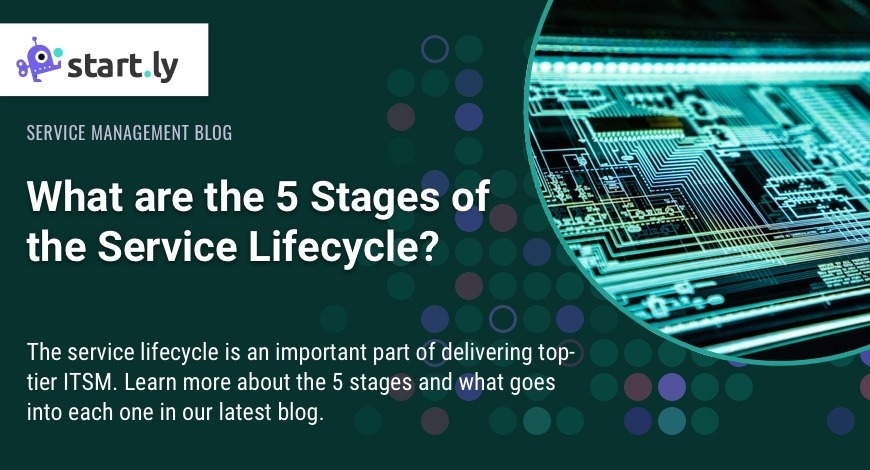Some of the most-well known and prominent cycles in life have 5 stages. The cell cycle, the grief cycle, even puberty break up into 5 phases. Today, we are adding another item to that list by discussing the ITIL service lifecycle.
The service lifecycle, also known as the ITIL service management processes, is a key part of implementing top tier IT service management. Before we get too far ahead of ourselves though, let’s break down a couple of those terms we just threw at you.
- IT Service Management (ITSM) is the set of activities performed by an organization to design, build, implement, support and maintain information technology systems and services offered to customers.
- ITIL is shorthand for Information Technology Infrastructure Library. Essentially, ITIL is a set of detailed practices for activities like IT service management or asset management and focuses on aligning IT services with the needs of a business or organization.
It is worth noting that the ITIL process and IT service management in general are often interchangeable terms, and at the very least share a hefty amount of overlap. Now that we have these major terms defined, we can keep moving. The remainder of this blog will look to answer the questions of: What are the 5 stages of ITIL framework and what is its purpose?
What are the Stages of the Service Life Cycle?
In general, when people refer to the service life cycle, more often than not they are referring to ITIL and/or ITSM. ITIL is updated as needed and has several versions. Within the ITIL lifecycle, in particular version 3, there are 5 stages.
What are the 5 Stages of the Service Lifecycle Defined in ITIL?
- The first stage of the service lifecycle is service strategy. Service strategy is at the heart of the service lifecycle because in order to have a better service you need to have a consistent service strategy. The objective of this stage is to decide on that strategy.
You should start by assessing the needs of your customers as well as the marketplace. Once you do that, you should determine which services your IT organization is going to offer and what components need to be developed in order to deliver those offerings. The end goal is to align the business objectives and strategies with your long-term vision.
- The second stage is service design. This stage is pretty straightforward and marks the shift from ideas into action, as you will design the new IT services you plan to deliver. This process consists of not only designing new components, but also upgrading existing ones.
Again, when designing services, you should take into consideration what your customers want. What kind of value are they looking for? What would delight them? In this stage, it is critical to act with attention to detail and foresight.
- Third in the lifecycle is service transition. The main goal of this stage is to build the IT services and introduce them into a live environment. This stage also consists of testing, since this is the last stage before providing the services to the customers.
It is important to test for all possible scenarios and ensure there are no glitches when the service is delivered to the customer. Additionally, you will want to make sure that any changes or updates to the service management process are executed in an organized and deliberate way.
- Service Operation is the fourth stage of the ITIL lifecycle. In this stage the goal is to ensure all IT services are delivered effectively and efficiently. A big part of this stage is making sure that customers are satisfied with the services. This includes things like fixing problems, carrying out user requests, resolving failures and issues as well as executing routine operational tasks.
At this stage, there is some level of agreement between the customer and service provider. That means the service providers must ensure they uphold their end of the bargain.
- The fifth and final stage of the service delivery lifecycle is continual service improvement. Like it sounds, the objective of this stage is to continuously monitor and revise the services and the key performance indicators. As you meet your initial goals and targets, set new ones. As the service is used, refine it for better performance. This process is meant to continually improve the effectiveness and efficiency of IT processes and services.
One key to this stage is to continually learn from successes and failures across your company. Failures on one project might inform a new approach on a different project.
Startly…A Better Tool for Better ITSM Providers
At Startly, we know one of the main pain points for ITSM providers is all of the different software platforms you need to get the job done. You might be paying for four or five different services, like ticketing, project management, time tracking, payroll, business insights and more.
Aside from all the chaos that comes with trying to stay on top of so many platforms, oftentimes the different software stacks you use don’t cooperate very well together. This can cause hassle and headaches. Enter Startly.
Startly is an all-in-one solution for all your professional services. We are easy to use, cost-effective, and committed to delivering the best product and service in the industry. Learn more about Startly and start using it for free.

